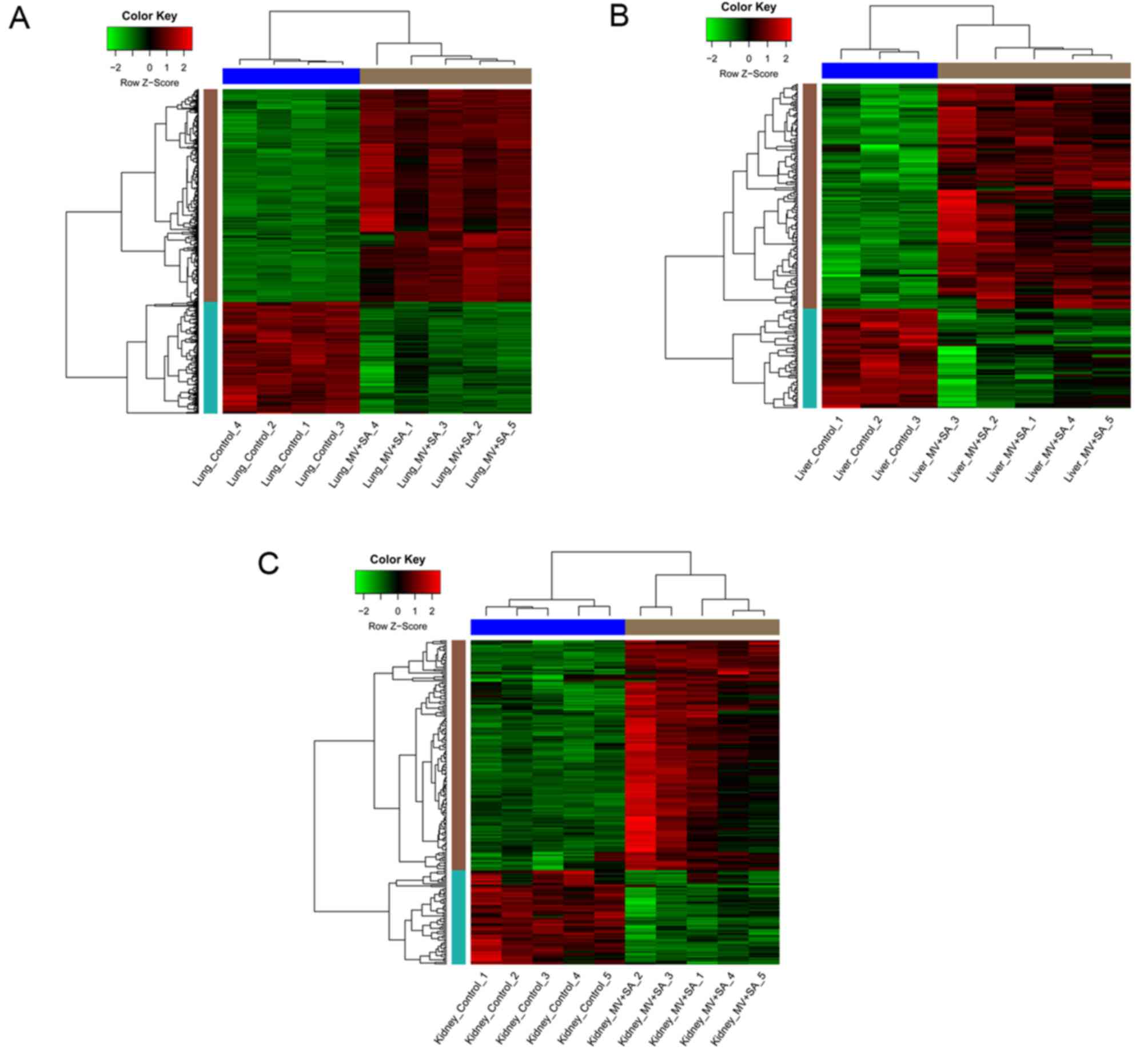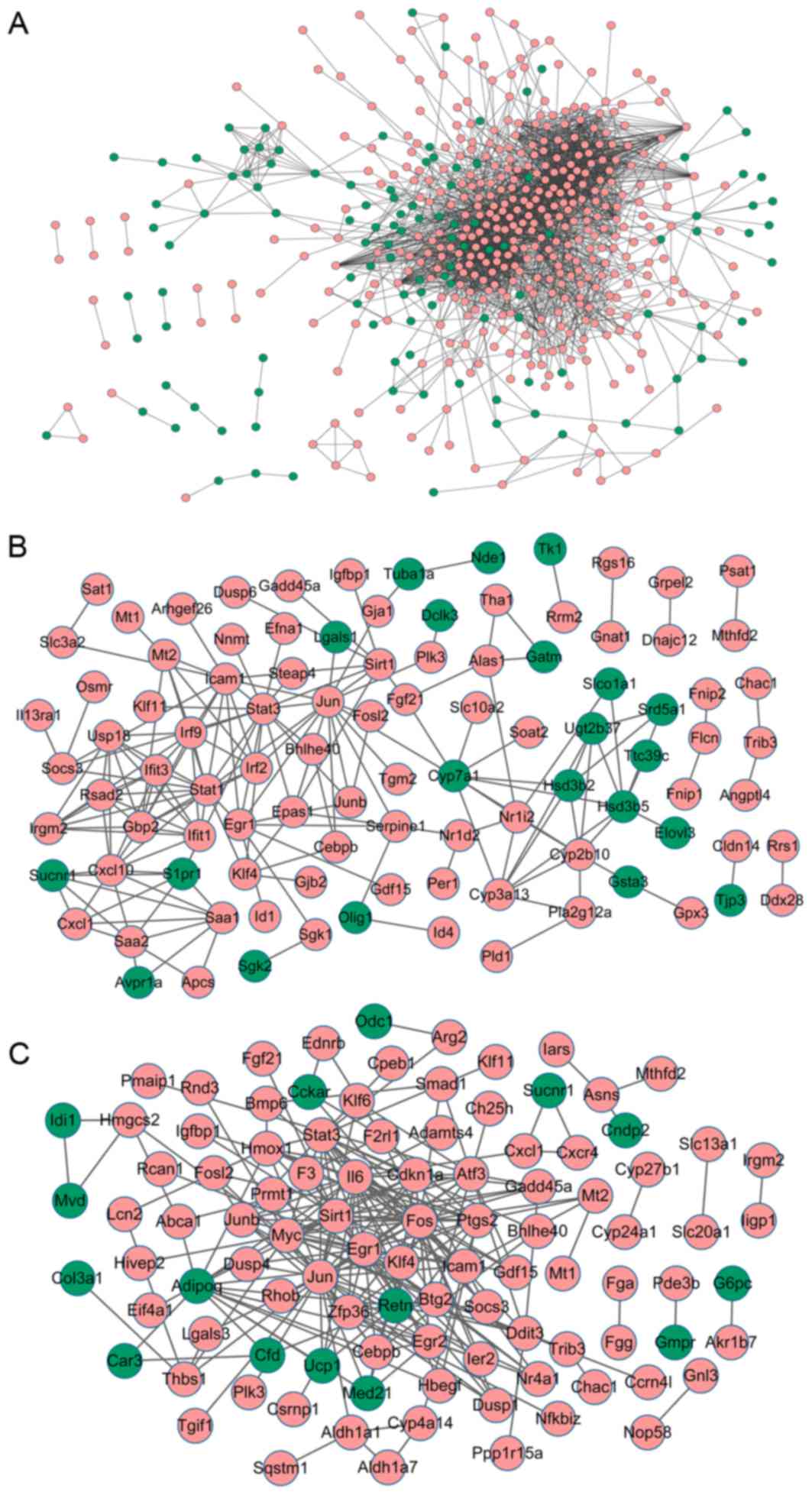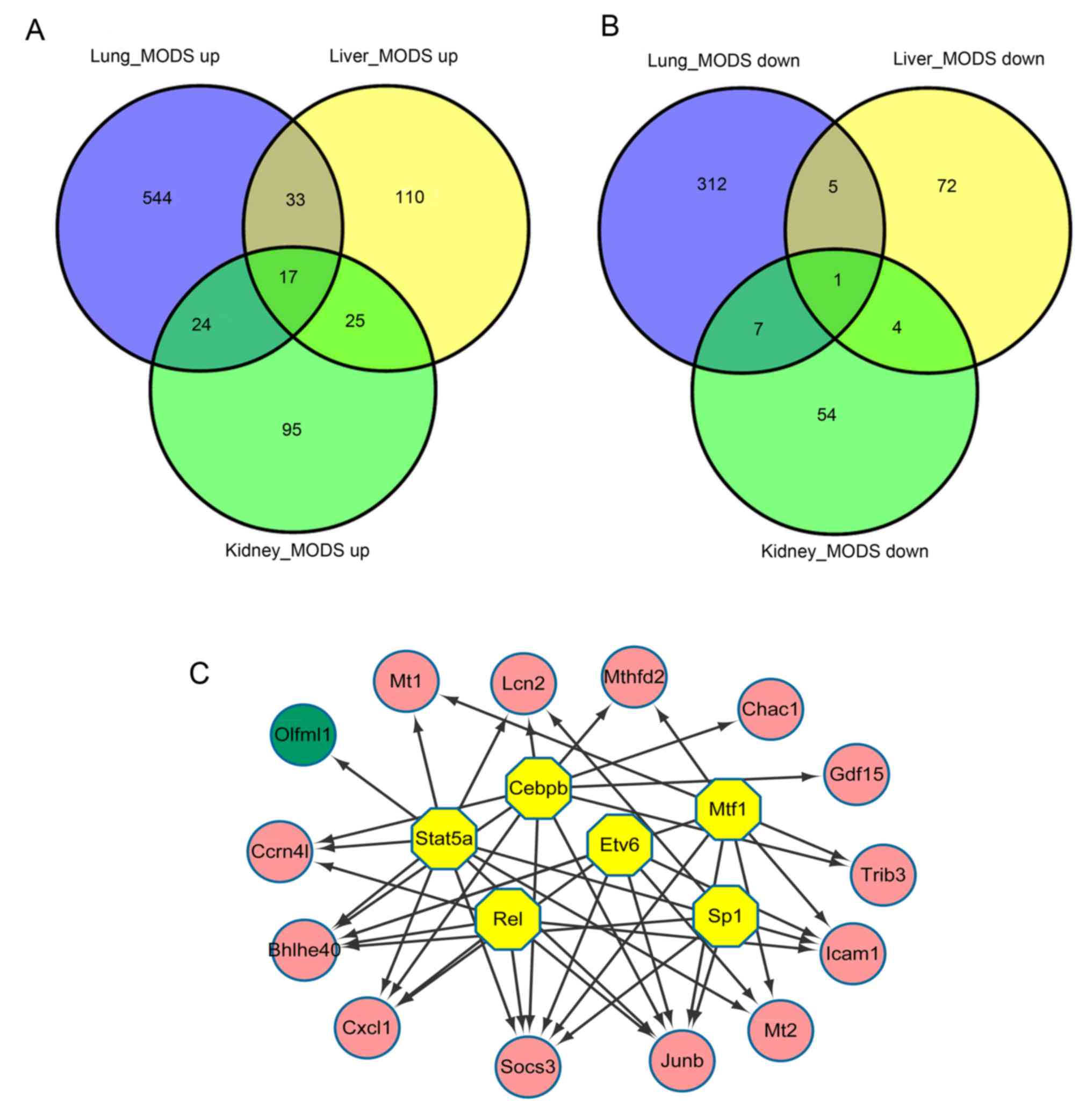|
1
|
Volman TJ, Hendriks T and Goris RJ:
Zymosan-induced generalized inflammation: Experimental studies into
mechanisms leading to multiple organ dysfunction syndrome. Shock.
23:291–297. 2005. View Article : Google Scholar : PubMed/NCBI
|
|
2
|
Henao FJ, Daes JE and Dennis RJ: Risk
factors for multiorgan failure: A case-control study. J Trauma.
31:74–80. 1991. View Article : Google Scholar : PubMed/NCBI
|
|
3
|
Deitch EA: Multiple organ failure.
Pathophysiology and potential future therapy. Ann Surg.
216:117–134. 1992. View Article : Google Scholar : PubMed/NCBI
|
|
4
|
Marshall JC: Inflammation, coagulopathy,
and the pathogenesis of multiple organ dysfunction syndrome. Crit
Care Med. 29 7 Suppl:S99–S106. 2001. View Article : Google Scholar : PubMed/NCBI
|
|
5
|
Wang H and Ma S: The cytokine storm and
factors determining the sequence and severity of organ dysfunction
in multiple organ dysfunction syndrome. Am J Emerg Med. 26:711–715.
2008. View Article : Google Scholar : PubMed/NCBI
|
|
6
|
Gustot T: Multiple organ failure in
sepsis: Prognosis and role of systemic inflammatory response. Curr
Opin Crit Care. 17:153–159. 2011. View Article : Google Scholar : PubMed/NCBI
|
|
7
|
Henninger DD, Panés J, Eppihimer M,
Russell J, Gerritsen M, Anderson DC and Granger DN:
Cytokine-induced VCAM-1 and ICAM-1 expression in different organs
of the mouse. J Immunol. 158:1825–1832. 1997.PubMed/NCBI
|
|
8
|
Bratt J and Palmblad J: Cytokine-induced
neutrophil-mediated injury of human endothelial cells. J Immunol.
159:912–918. 1997.PubMed/NCBI
|
|
9
|
Crouser ED: Mitochondrial dysfunction in
septic shock and multiple organ dysfunction syndrome.
Mitochondrion. 4:729–741. 2004. View Article : Google Scholar : PubMed/NCBI
|
|
10
|
Suzuki T, Takahashi T, Yamasaki A,
Fujiwara T, Hirakawa M and Akagi R: Tissue-specific gene expression
of heme oxygenase-1 (HO-1) and non-specific delta-aminolevulinate
synthase (ALAS-N) in a rat model of septic multiple organ
dysfunction syndrome. Biochem Pharmacol. 60:275–283. 2000.
View Article : Google Scholar : PubMed/NCBI
|
|
11
|
Rockey DC, Bell PD and Hill JA: Fibrosis-a
common pathway to organ injury and failure. N Engl J Med.
372:1138–1149. 2015. View Article : Google Scholar : PubMed/NCBI
|
|
12
|
Bunney WE, Bunney BG, Vawter MP, Tomita H,
Li J, Evans SJ, Choudary PV, Myers RM, Jones EG, Watson SJ and Akil
H: Microarray technology: A review of new strategies to discover
candidate vulnerability genes in psychiatric disorders. Am J
Psychiatry. 160:657–666. 2003. View Article : Google Scholar : PubMed/NCBI
|
|
13
|
Nylund L, Satokari R, Nikkilä J,
Rajilić-Stojanović M, Kalliomäki M, Isolauri E, Salminen S and De
Vos WM: Microarray analysis reveals marked intestinal microbiota
aberrancy in infants having eczema compared to healthy children in
at-risk for atopic disease. BMC Microbiol. 13:122013. View Article : Google Scholar : PubMed/NCBI
|
|
14
|
Maslove DM and Wong HR: Gene expression
profiling in sepsis: Timing, tissue, and translational
considerations. Trends Mol Med. 20:204–213. 2014. View Article : Google Scholar : PubMed/NCBI
|
|
15
|
Gutschner T, Hämmerle M, Eissmann M, Hsu
J, Kim Y, Hung G, Revenko A, Arun G, Stentrup M, Gross M, et al:
The noncoding RNA MALAT1 is a critical regulator of the metastasis
phenotype of lung cancer cells. Cancer Res. 73:1180–1189. 2013.
View Article : Google Scholar : PubMed/NCBI
|
|
16
|
Di Narzo AF, Tejpar S, Rossi S, Yan P,
Popovici V, Wirapati P, Budinska E, Xie T, Estrella H, Pavlicek A,
et al: Test of four colon cancer risk-scores in formalin fixed
paraffin embedded microarray gene expression data. J Natl Cancer
Inst. 106:pii: dju247. 2014. View Article : Google Scholar : PubMed/NCBI
|
|
17
|
Gharib SA, Mar D, Bomsztyk K, Denisenko O,
Dhanireddy S, Liles WC and Altemeier WA: System-wide mapping of
activated circuitry in experimental systemic inflammatory response
syndrome. Shock. 45:148–156. 2016. View Article : Google Scholar : PubMed/NCBI
|
|
18
|
Gautier L, Cope L, Bolstad BM and Irizarry
RA: affy-analysis of Affymetrix GeneChip data at the probe level.
Bioinformatics. 20:307–315. 2004. View Article : Google Scholar : PubMed/NCBI
|
|
19
|
Carlson M, Falcon S, Pages H and Li N:
org. Mm. eg. db: Genome wide annotation for Mouse. org. Mm. eg. db:
Genome wide annotation for Mouse. R package version. 2012.
|
|
20
|
Carlson M: Mouse4302.db: Affymetrix Mouse
genome 430 2.0 array annotation data (chip mouse4302). R package.
version 3.1.3. 2016.
|
|
21
|
Smyth GK: Limma: linear models for
microarray dataBioinformatics and Computational Biology Solutions
Using R and Bioconductor. Gentleman R, Carey V, Huber W, Irizarry R
and Dudoit S: Springer; New York, NY: pp. 397–420. 2005, View Article : Google Scholar
|
|
22
|
Glueck DH, Mandel J, Karimpour-Fard A,
Hunter L and Muller KE: Exact calculations of average power for the
Benjamini-Hochberg procedure. Int J Biostat. 4:Article 11. 2008.
View Article : Google Scholar : PubMed/NCBI
|
|
23
|
Warnes GR, Bolker B, Bonebakker L,
Gentleman R, Huber W, Liaw A, Lumley T, Maechler M, Magnusson A,
Moeller S, et al: gplots: Various R programming tools for plotting
data. R package. version 2. 2009.
|
|
24
|
Kolde R: Pretty heatmaps. 2015.https://cran.r-project.org/web/packages/pheatmap/pheatmap.pdfDecember
11–2015
|
|
25
|
Huang DW, Sherman BT, Tan Q, Collins JR,
Alvord WG, Roayaei J, Stephens R, Baseler MW, Lane HC and Lempicki
RA: The DAVID gene functional classification tool: A novel
biological module-centric algorithm to functionally analyze large
gene lists. Genome Biol. 8:R1832007. View Article : Google Scholar : PubMed/NCBI
|
|
26
|
Szklarczyk D, Franceschini A, Wyder S,
Forslund K, Heller D, Huerta-Cepas J, Simonovic M, Roth A, Santos
A, Tsafou KP, et al: STRING v10: Protein-protein interaction
networks, integrated over the tree of life. Nucleic Acids Res.
43:(Database Issue). D447–D452. 2015. View Article : Google Scholar : PubMed/NCBI
|
|
27
|
Kohl M, Wiese S and Warscheid B:
Cytoscape: Software for visualization and analysis of biological
networks. Methods Mol Biol. 696:291–303. 2011. View Article : Google Scholar : PubMed/NCBI
|
|
28
|
Janky R, Verfaillie A, Imrichová H, Van de
Sande B, Standaert L, Christiaens V, Hulselmans G, Herten K,
Sanchez Naval M, Potier D, et al: iRegulon: From a gene list to a
gene regulatory network using large motif and track collections.
PLoS Comput Biol. 10:e10037312014. View Article : Google Scholar : PubMed/NCBI
|
|
29
|
Booth V, Keizer DW, Kamphuis MB,
Clark-Lewis I and Sykes BD: The CXCR3 binding chemokine
IP-10/CXCL10: Structure and receptor interactions. Biochemistry.
41:10418–10425. 2002. View Article : Google Scholar : PubMed/NCBI
|
|
30
|
Haskill S, Peace A, Morris J, Sporn SA,
Anisowicz A, Lee SW, Smith T, Martin G, Ralph P and Sager R:
Identification of three related human GRO genes encoding cytokine
functions. Proc Natl Acad Sci USA. 87:7732–7736. 1990. View Article : Google Scholar : PubMed/NCBI
|
|
31
|
Panzer U, Steinmetz OM, Paust HJ,
Meyer-Schwesinger C, Peters A, Turner JE, Zahner G, Heymann F,
Kurts C, Hopfer H, et al: Chemokine receptor CXCR3 mediates T cell
recruitment and tissue injury in nephrotoxic nephritis in mice. J
Am Soc Nephrol. 18:2071–2084. 2007. View Article : Google Scholar : PubMed/NCBI
|
|
32
|
Jastrow KM III, Gonzalez EA, McGuire MF,
Suliburk JW, Kozar RA, Iyengar S, Motschall DA, McKinley BA, Moore
FA and Mercer DW: Early cytokine production risk stratifies trauma
patients for multiple organ failure. J Am Coll Surg. 209:320–331.
2009. View Article : Google Scholar : PubMed/NCBI
|
|
33
|
Robertson CM and Coopersmith CM: The
systemic inflammatory response syndrome. Microbes Infect.
8:1382–1389. 2006. View Article : Google Scholar : PubMed/NCBI
|
|
34
|
Bhatia M and Hegde A: Treatment with
antileukinate, a CXCR2 chemokine receptor antagonist, protects mice
against acute pancreatitis and associated lung injury. Regul Pept.
138:40–48. 2007. View Article : Google Scholar : PubMed/NCBI
|
|
35
|
Quelle FW, Thierfelder W, Witthuhn BA,
Tang B, Cohen S and Ihle JN: Phosphorylation and activation of the
DNA binding activity of purified Stat1 by the Janus
protein-tyrosine kinases and the epidermal growth factor receptor.
J Biol Chem. 270:20775–20780. 1995. View Article : Google Scholar : PubMed/NCBI
|
|
36
|
Durbin JE, Hackenmiller R, Simon MC and
Levy DE: Targeted disruption of the mouse Stat1 gene results in
compromised innate immunity to viral disease. Cell. 84:443–450.
1996. View Article : Google Scholar : PubMed/NCBI
|
|
37
|
Oiva J, Mustonen H, Kylänpää ML, Kyhälä L,
Alanärä T, Aittomäki S, Siitonen S, Kemppainen E, Puolakkainen P
and Repo H: Patients with acute pancreatitis complicated by organ
failure show highly aberrant monocyte signaling profiles assessed
by phospho-specific flow cytometry. Crit Care Med. 38:1702–1708.
2010. View Article : Google Scholar : PubMed/NCBI
|
|
38
|
Boengler K, Hilfiker-Kleiner D, Drexler H,
Heusch G and Schulz R: The myocardial JAK/STAT pathway: From
protection to failure. Pharmacol Ther. 120:172–185. 2008.
View Article : Google Scholar : PubMed/NCBI
|
|
39
|
Li Y, Zhao M, Yin H, Gao F, Wu X, Luo Y,
Zhao S, Zhang X, Su Y, Hu N, et al: Overexpression of the growth
arrest and DNA damage-induced 45alpha gene contributes to
autoimmunity by promoting DNA demethylation in lupus T cells.
Arthritis Rheum. 62:1438–1447. 2010. View Article : Google Scholar : PubMed/NCBI
|
|
40
|
Zhan Q: Gadd45a, a p53-and BRCA1-regulated
stress protein, in cellular response to DNA damage. Mutat Res.
569:133–143. 2005. View Article : Google Scholar : PubMed/NCBI
|
|
41
|
Altemeier WA, Matute-Bello G, Gharib SA,
Glenny RW, Martin TR and Liles WC: Modulation of
lipopolysaccharide-induced gene transcription and promotion of lung
injury by mechanical ventilation. J Immunol. 175:3369–3376. 2005.
View Article : Google Scholar : PubMed/NCBI
|
|
42
|
Uhlig U, Haitsma JJ, Goldmann T, Poelma
DL, Lachmann B and Uhlig S: Ventilation-induced activation of the
mitogen-activated protein kinase pathway. Eur Respir J. 20:946–956.
2002. View Article : Google Scholar : PubMed/NCBI
|
|
43
|
Li LF, Yu L and Quinn DA:
Ventilation-induced neutrophil infiltration depends on c-Jun
N-terminal kinase. Am J Respir Crit Care Med. 169:518–524. 2004.
View Article : Google Scholar : PubMed/NCBI
|
|
44
|
McGhan LJ and Jaroszewski DE: The role of
toll-like receptor-4 in the development of multi-organ failure
following traumatic haemorrhagic shock and resuscitation. Injury.
43:129–136. 2012. View Article : Google Scholar : PubMed/NCBI
|
|
45
|
Cooks T, Harris CC and Oren M: Caught in
the cross fire: p53 in inflammation. Carcinogenesis. 35:1680–1690.
2014. View Article : Google Scholar : PubMed/NCBI
|
|
46
|
Wang W, Bergh A and Damber JE: Increased
expression of CCAAT/enhancer-binding protein beta in proliferative
inflammatory atrophy of the prostate: Relation with the expression
of COX-2, the androgen receptor, and presence of focal chronic
inflammation. Prostate. 67:1238–1246. 2007. View Article : Google Scholar : PubMed/NCBI
|
|
47
|
Bal RS and Anholt RR: Formation of the
extracellular mucous matrix of olfactory neuroepithelium:
Identification of partially glycosylated and nonglycosylated
precursors of olfactomedin. Biochemistry. 32:1047–1053. 1993.
View Article : Google Scholar : PubMed/NCBI
|
|
48
|
Takatori H, Nakajima H, Kagami S, Hirose
K, Suto A, Suzuki K, Kubo M, Yoshimura A, Saito Y and Iwamoto I:
Stat5a inhibits IL-12-induced Th1 cell differentiation through the
induction of suppressor of cytokine signaling 3 expression. J
Immunol. 174:4105–4112. 2005. View Article : Google Scholar : PubMed/NCBI
|
|
49
|
Takatori H, Nakajima H, Hirose K, Kagami
S, Tamachi T, Suto A, Suzuki K, Saito Y and Iwamoto I:
Indispensable role of Stat5a in Stat6-independent Th2 cell
differentiation and allergic airway inflammation. J Immunol.
174:3734–3740. 2005. View Article : Google Scholar : PubMed/NCBI
|
|
50
|
Wei L, Laurence A and O'Shea JJ: New
insights into the roles of Stat5a/b and Stat3 in T cell development
and differentiation. Semin Cell Dev Biol. 19:394–400. 2008.
View Article : Google Scholar : PubMed/NCBI
|













